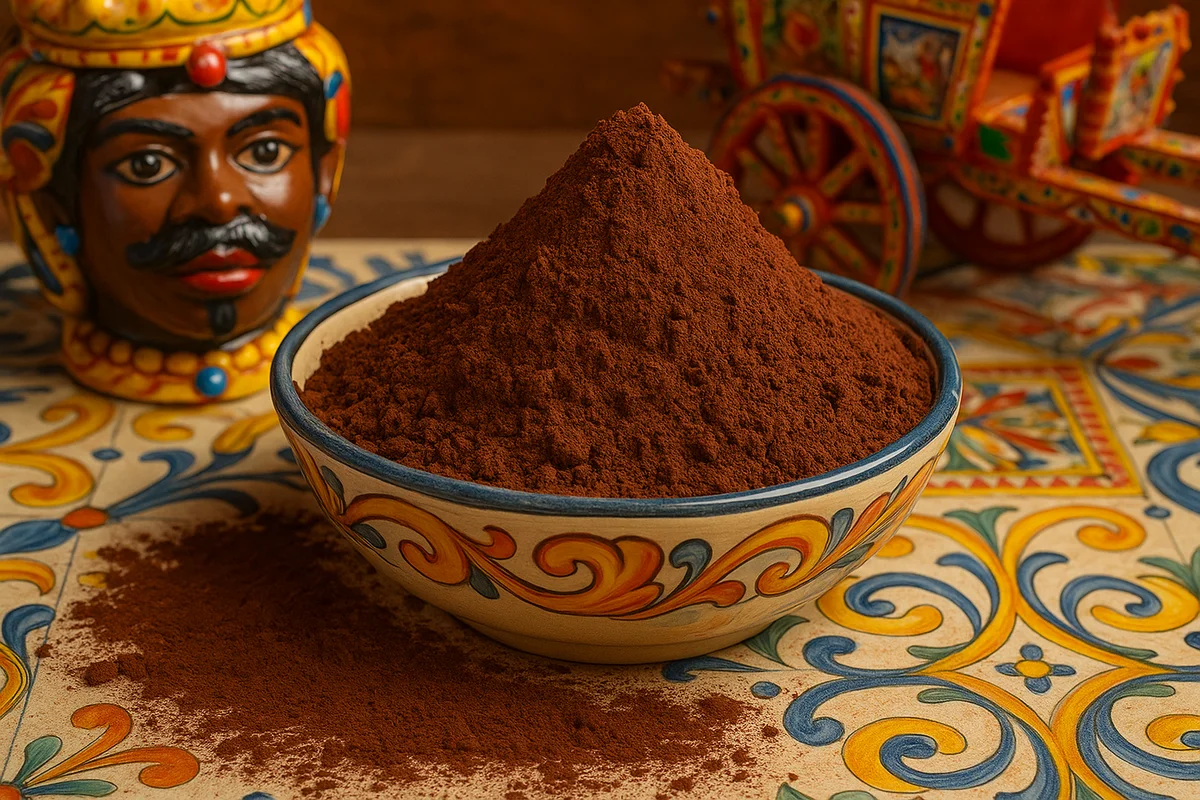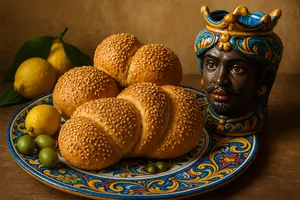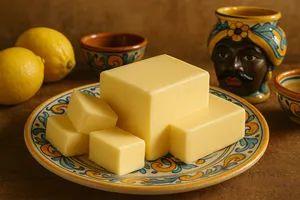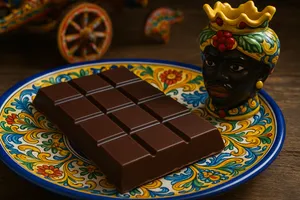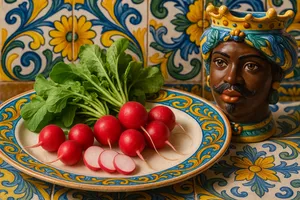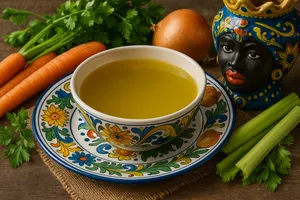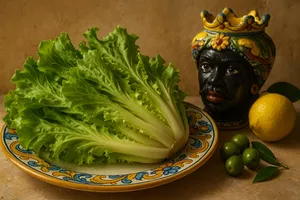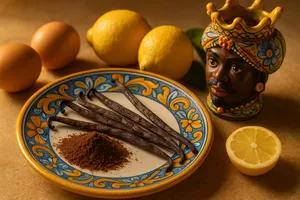Overview
Cocoa powder is a precious and versatile ingredient in Sicilian pastry-making, obtained from the processing of cocoa beans, the seeds of the Theobroma cacao plant. Although not native to the island, cocoa was embraced with enthusiasm by Sicilian confectionery traditions as soon as it reached Europe, becoming central to numerous traditional and modern preparations.
In Sicily, cocoa found fertile ground within the island’s rich pastry culture, blending with local ingredients such as almonds, pistachios, and ricotta to create unique confections. From chocolate granita to cassate made with cocoa sponge cake, from biscuits to pantry desserts, cocoa has become indispensable, harmonising effortlessly with Mediterranean flavours while retaining its intense, enveloping character.
Characteristics
Cocoa powder appears as a fine brown powder, ranging from light to very dark brown, almost black, depending on the type and degree of roasting. It has an intense, distinctive aroma reminiscent of chocolate, yet more bitter and complex.
Its flavour is bitter and astringent when used pure, a characteristic due to tannins and alkaloids such as theobromine. This bitterness is balanced by sugar in sweet preparations, where cocoa reveals its full aromatic richness.
Cocoa quality is judged by the intensity of its aroma, fineness of texture, and purity. Good cocoa should be free of lumps, have an even colour, and release a strong fragrance as soon as the container is opened.
Types
Two main kinds of cocoa powder are commonly used in pastry-making.
Natural unsweetened cocoa
Produced by simply grinding roasted cocoa beans after the cocoa butter has been removed. It has an acidic pH (around 5–6) and a distinctly bitter taste. It is light brown and used in preparations requiring an intense, unmodified chocolate flavour.
Alkalised (Dutch-processed) cocoa
Treated with alkaline substances that neutralise acidity, raising the pH to 7–8. This process, called “dutching”, darkens the cocoa to a reddish-brown or almost black colour, softens the bitterness, and improves solubility in liquids. It is preferred for beverages and certain sweet preparations.
Use in pastry-making
In Sicilian pastry-making, cocoa is used in many traditional and contemporary creations.
Cocoa sponge cake
A fundamental base for many Sicilian desserts, cocoa sponge cake is made by replacing part of the flour with cocoa powder. It is used for cassate, semifreddi, and filled cakes.
Biscuits and dry pastries
Cocoa enriches numerous Sicilian biscuits, from simple cocoa biscuits to more elaborate chocolate almond pastries, where it pairs perfectly with the sweetness of almonds.
Creams and fillings
Cocoa cream is used to fill cannoli, cassate, and other desserts. It is prepared by mixing cocoa with milk, sugar, eggs, and starch to create a velvety, fragrant cream.
Chocolate granita
One of Sicily’s most beloved granitas, made with cocoa, sugar, starch, and water to create an intense, refreshing granita, perfect when served with warm brioche.
Gelato and semifreddi
Cocoa is a key ingredient in Sicilian chocolate gelato, known for its intense flavour and creamy texture. In semifreddi, it adds both structure and depth of flavour.
Decorations
Cocoa powder is used for dusting desserts, tiramisù, cappuccinos, and for creating decorations on cakes and plated desserts.
Traditional Sicilian preparations
Several Sicilian sweets feature cocoa as a main or complementary ingredient.
Chocolate gelo
A traditional chocolate pudding from Palermo made with cocoa, starch, milk, and sugar, scented with cinnamon and served chilled, decorated with jasmine or chopped pistachio.
Chocolate mustazzoli
Traditional Sicilian Christmas biscuits prepared with flour, cocoa, almonds, honey, and spices, coated with a sugar glaze.
Cassata with cocoa sponge
A variation of the classic Sicilian cassata in which the white sponge cake is alternated with layers of cocoa sponge, creating a pleasing visual and flavour contrast.
Nutritional properties
Unsweetened cocoa is surprisingly nutritious and rich in beneficial compounds. It contains about 230 calories per 100 grams, with a good amount of protein (around 20 grams) and fibre (about 30 grams).
It is rich in minerals, particularly magnesium, iron, potassium, phosphorus, and zinc. It also contains powerful antioxidants known as flavonoids, which have demonstrated numerous cardiovascular benefits.
Cocoa contains theobromine and small amounts of caffeine, stimulants that contribute to its energising effect. It is also a source of tryptophan, an amino acid precursor of serotonin, the so-called “feel-good hormone”.
It is important to note that these benefits apply to pure unsweetened cocoa: when used in sweet preparations with added sugars and fats, the nutritional profile changes significantly.
Storage
Cocoa powder keeps very well if protected from humidity, heat, and light. It should be stored in an airtight container, preferably glass or metal, in a cool, dry place.
When stored correctly, cocoa retains its properties for 2–3 years, though it may gradually lose some aroma over time. Always check for the absence of lumps or unusual odours before use.
Cocoa absorbs surrounding aromas, so it should be kept away from spices, coffee, or other strongly scented ingredients. It should never be stored in the refrigerator, as humidity can cause clumping.
Tips for use
For best results in pastry-making, cocoa should always be sifted before use to remove lumps and incorporate air, making preparations lighter. When replacing part of the flour with cocoa in a recipe, the general rule is 3 tablespoons of cocoa for every 30 grams of flour removed.
Natural cocoa reacts with bicarbonate of soda, aiding leavening and giving preparations a darker colour. Alkalised cocoa is more neutral and used with standard baking powders.
To enhance its aroma, some Sicilian pastry chefs add a pinch of coffee to cocoa-based preparations, which intensifies the flavour without overpowering it. A small pinch of salt also helps balance bitterness and highlight the aromatic notes.
Tips for buying
When buying cocoa powder, choose products with a high cocoa content (at least 20–22% fat) for the best aroma and flavour. Reading labels is essential: pure cocoa should contain only cocoa, with no added sugars or other ingredients.
High-quality cocoa often comes from specific growing regions (such as Ecuador, Madagascar, or Ghana) and may be labelled “fine cocoa” or “criollo/trinitario cocoa”. Price is generally a good indicator: superior cocoa costs more than standard commercial varieties.
It is preferable to buy cocoa in glass or metal jars rather than bags, as these offer better protection from moisture and light.
Curiosities
Cocoa arrived in Europe after the discovery of the Americas, but it took time to reach Sicily. It was the island’s convents and monasteries—with their pastry workshops—that first experimented with cocoa in desserts, creating recipes that combined this exotic ingredient with local almonds, pistachios, and ricotta.
In Modica, a Baroque town in southeastern Sicily, a unique tradition of “cold-processed” chocolate developed, likely influenced by Spanish rule. Modican chocolate, made with cocoa, sugar, and spices, retains a characteristic granular texture and is now an IGP product.
In Sicilian folk medicine, cocoa was considered restorative and given to children who were weak or lacking appetite in the form of a sweetened hot drink affectionately called “ciucculatta” in dialect.
The scientific name of the cocoa plant, “Theobroma”, literally means “food of the gods” in Greek, a name given by the botanist Carl Linnaeus in the eighteenth century, reflecting the esteem in which cocoa was held.
In many historic Sicilian pastry shops, cocoa is still purchased in blocks or cocoa mass, which is then ground finely just before use—a technique that ensures a richer, fresher aroma compared with industrially packaged cocoa powder.

